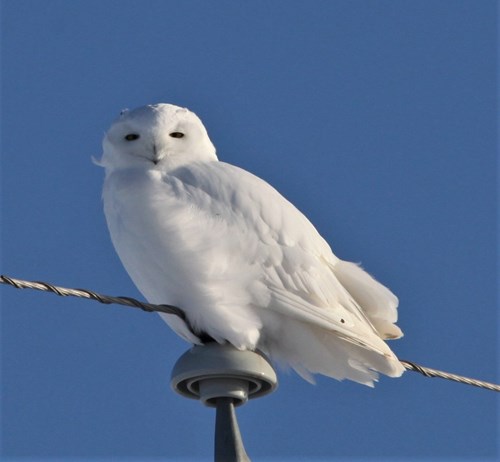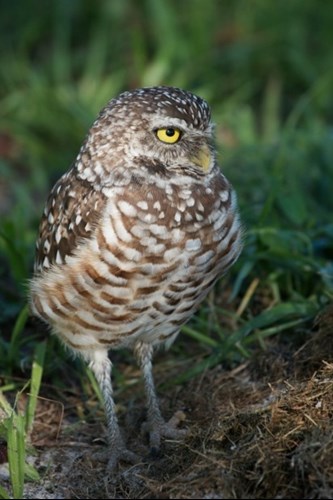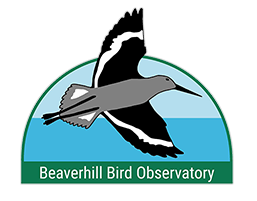Impacts of Climate Change on Owls
Friday, March 27, 2020Snowy Owls & Burrowing Owls 101
Snowy Owls are one of the largest owls by weight in North America. As the name hints, Snowy Owls are a snowy-white owl that live in the Arctic during summer months and migrates south during the winter. Their wintering grounds extends between the east and west coast of Canada encompassing almost the entire country, and extends into the northern United States.
Burrowing Owls, on the other hand, are a grasslands bird species. Found in the prairies, they occupy abandoned burrows made by other animals, making them the only owl in North America that nests underground. Wintering in Mexico and the south-western United States, western Burrowing Owls migrate north during summer months, and among other places, nests in Alberta and Saskatchewan. Burrowing Owls in Florida are non-migratory. In this blog, we will learn about the conservation concerns, including the impacts of climate change, for these two owl species.
 Snowy Owls & Climate Change
Snowy Owls & Climate Change
One of the biggest threats that climate change posses for Snowy Owls is its impact on their prey source, i.e., lemmings. Lemmings are a small Arctic rodent which comprises the majority of Snowy Owls’ diet while nesting in the Arctic. An adult Snowy Owl can eat up to 1,600 lemmings in a year! These rodents survive the Arctic winters by eating mosses which grow abundantly throughout the region. Typically in winter the lemmings forage under the snow, protected from the extreme cold by the snow insulation. Climate change, however, is causing thawing-freezing events to occur, meaning melting water floods into their tunnels and when it freezes, it traps that moss in a layer of ice, limiting the lemmings’ food supply. This in turn is causing many of them to die of starvation. When lemming populations decline, predators like the Snowy Owls also suffer due to their reliance on this rodent supply. In fact, scientist have found that in times of lemming scarcity, some owls may not reproduce at all. In east Greenland, it has been documented that when the lemming populations crashed, the local Snowy Owl population disappears completely! Therefore, as the lemming populations continue to decline, fueled by the impacts of climate change, it could severely jeopardize Snowy Owl populations. Here in North America, our Snowy Owl populations have already suffered a sharp decline of 64% between 1970 and 2014, and it is estimated that the current population has just under 30,000 individuals remaining.
Another impact of climate change on Snowy Owls is the melting of Arctic permafrost, a layer of ground substrate that remains frozen year-round. Permafrost is the underlying foundation of the Arctic tundra and with the warming effects of climate change, we are seeing that layer beginning to melt. This is changing the Arctic ecosystem from a historically solid tundra habitat, to a region of mud and silt, with increasing pools of water, and causing erosion to occur. This melting effect is degrading and reducing the habitat that Snowy Owls require in order to reproduce and survive.
 Burrowing Owls & Climate Change
Burrowing Owls & Climate Change
Since the 1970s, Burrowing Owl populations have been on the decline. Particularly here in Canada, the causes for these declines include; habitat loss and fragmentation, decline in prey abundance resulting in fewer young, decline in available burrows, and vehicle mortality. The most recent estimates put the current Canadian population of Burrowing Owls at under 500 nesting pairs. Their small and declining population makes Burrowing Owls extremely vulnerable to the impacts of climate change.
Climate change is increasing the frequency and intensity of extreme weather events, such as droughts and heavy rainfalls, in the Canada prairies, i.e., within Burrowing Owl territory. Studies show that heavy precipitation events have increased in the prairies between 1945 and 1995, and since 2000, the prairies have witnessed some of the wettest summers in history, with 2010 being the second wettest in over 60 years. What is the impact of heavy rainfall events on Burrowing Owls? Heavy rain can lead to mass starvation of Burrowing Owl chicks as the parents may fail to bring enough food to feed them due to the poor wet weather. Heavy rain can also flood the burrows, which can cause a complete nest failure, damage the burrows, and limit habitat availability, as the owls rarely return to a damaged burrow. According to Audubon’s climate model, Burrowing Owls could lose up to 77% of their current breeding range due to climate change by 2080.
What Can We Do?
To stop climate change, you can reduce your carbon footprint by lowering your house and workplace thermostat, thereby, decreasing your energy consumption and carbon footprint. In the winter months, you can set your thermostat at 20 degree Celsius instead of 22 degree Celsius. If you use air conditioning in the summer months, you can adjust the setting to 24 degree Celsius instead of 22 degree Celsius. These minor changes will help you reduce your carbon footprint, while also saving you money with the electricity bills!
Other helpful tips on how to reduce your carbon footprint to help reduce climate change can be found on our website here.
Picture Credit:
Jongsun Lee, accessed on March 23, 2020, retrieved from https://commons.wikimedia.org/wiki/File:Snowy_Owl_(240866707).jpeg (picture cropped)
Dori, accessed on March 23, 2020, retrieved from https://commons.wikimedia.org/wiki/File:Burrowing_Owl_4216.jpg
Snowy Owl, by Irene Crosland. February 17, 2020
Additional Readings:
Gilg, Olivier, Benoit Sittler, and Ilkka Hanski. "Climate change and cyclic predator–prey population dynamics in the high Arctic." Global Change Biology 15, no. 11 (2009): 2634-2652.
Kausrud, Kyrre L., Atle Mysterud, Harald Steen, Jon Olav Vik, Eivind Østbye, Bernard Cazelles, Erik Framstad et al. "Linking climate change to lemming cycles." Nature 456, no. 7218 (2008): 93-97.
Fisher, Ryan J., and Erin M. Bayne. "Burrowing Owl climate change adaptation plan for Alberta." Prepared for the Biodiversity Management and Climate Change Adaptation project. Alberta Biodiversity Monitoring Institute, Edmonton, AB (2014). https://www.eralberta.ca/wp-content/uploads/2017/05/FisherandBayne_2014_BurrowingOwlAdaptationPlan.pdf
https://www.nytimes.com/2011/05/24/science/24owl.html
https://kids.nationalgeographic.com/animals/birds/snowy-owl/
https://www.nationalgeographic.com/animals/birds/s/snowy-owl/
https://www.allaboutbirds.org/guide/Snowy_Owl/lifehistory
https://www.allaboutbirds.org/guide/Burrowing_Owl/lifehistory
https://www.nytimes.com/2011/05/24/science/24owl.html
https://birdsna.org/Species-Account/bna/species/snoowl1/introduction
https://www.theguardian.com/environment/2014/feb/24/snowy-owl-lemming-population-us-canada
https://partnersinflight.org/wp-content/uploads/2016/08/pif-continental-plan-final-spread-single.pdf
https://climate2014.audubon.org/birds/burowl/burrowing-owl
http://www.mborp.ca/index.html
https://e360.yale.edu/features/how-melting-permafrost-is-beginning-to-transform-the-arctic
https://www.nationalgeographic.com/environment/habitats/tundra-threats/
https://www.arcgis.com/apps/MapJournal/index.html?appid=97dec6313b7147a481516ab6aeb71da3
https://albertawater.com/history-and-effects-of-climate-change-on-alberta-s-watersheds
https://changingclimate.ca/CCCR2019/chapter/4-0/
https://www.alberta.ca/climate-change-alberta.aspx
http://beaverhillbirds.com/media/1910/volume-3-report-3-impact-of-climate-change-on-shorebirds.pdf
Blog Posts
- What is Climate Change
- Drought: What Can We Do?
- Migration and Climate Change; a Complicated Relationship (Part 1)
- Migration and Climate Change; a Complicated Relationship (Part 2)
- Climate Change and Birds’ Resources
- Ladder to Extinction
- Arctic Warming and Ecosystem Impacts
- Climate Change Connection to Mountain Pine Beetle
- Tackling Climate Change Denialism
- Impact of Climate Change on Bluebirds
- An Introduction to Climate Change
- Great Decline of Aerial Insectivores
- Role of Oceans in Fighting Climate Change
- Role Of Forests In Fighting Climate Change
- Impact of Climate Change on Shorebirds
- Impact of Hurricanes and Climate Change on Birds
- An Introduction to Climate Change.
- Impact of Forest Fires, and Climate Change on the Nature
- Impacts of Climate Change on Owls
- Impacts of Climate Change on Birds of Prey
- Whitebark Pine and Clark's Nutcracker
- COVID 19 & The Environment
- Impact of Global Warming on Bird Anatomy and Colour Polymorphism
- Climate Change & West Nile Virus
- All Posts

